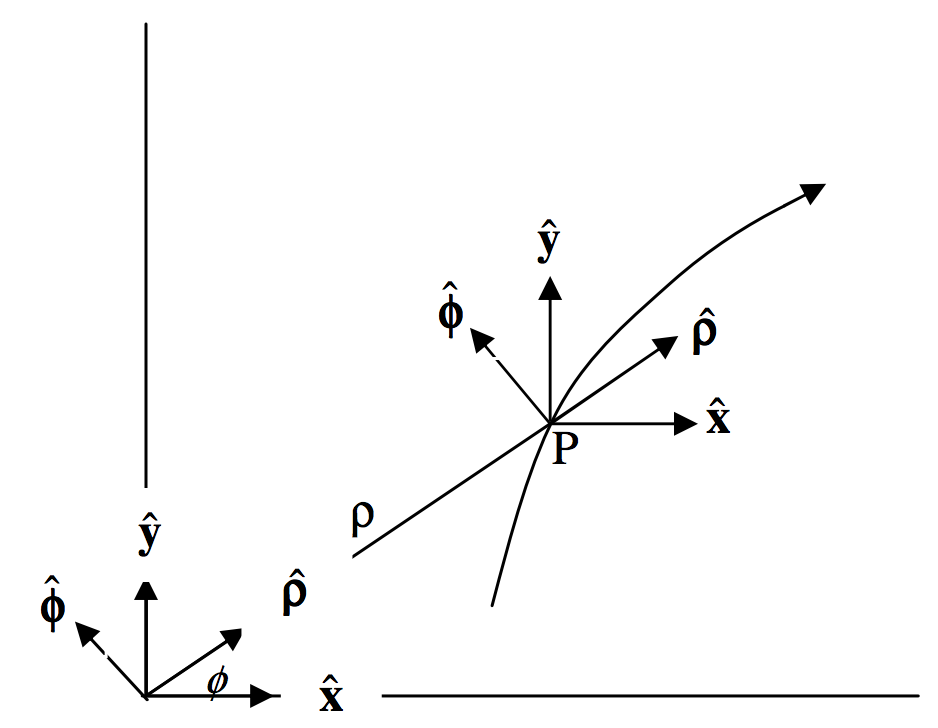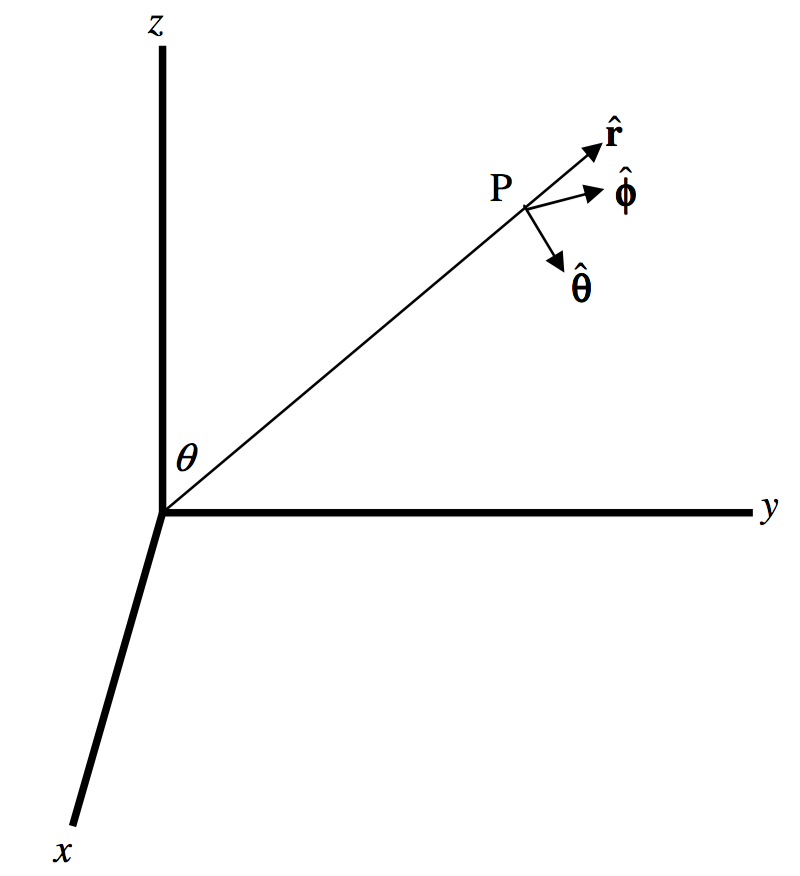3.4: Velocity and Acceleration Components
( \newcommand{\kernel}{\mathrm{null}\,}\)
Two-dimensional polar coordinates
Sometimes the symbols r and θ are used for two-dimensional polar coordinates, but in this section I use (ρ,ϕ) for consistency with the (r,θ,ϕ) of three-dimensional spherical coordinates. In what follows I am setting vectors in boldface. If you make a print-out, you should be aware that some printers apparently do not print Greek letter symbols in boldface, even though they appear in boldface on screen. You should be on the look-out for this. Symbols with ^ above them are intended as unit vectors, so you will know that they should be in boldface even if your printer does not recognize this. If in doubt, look at what appears on the screen.
FIGURE III.8

Figure III.8 shows a point P moving along a curve such that its polar coordinates are changing at rates ˙ρ and ˙ϕ. The drawing also shows fixed unit vectors ˆx and ˆy parallel to the x- and y-axes, as well as unit vectors ˆρ and ˆϕ in the radial and transverse directions. We shall find expressions for the rate at which the unit radial and transverse vectors are changing with time. (Being unit vectors, their magnitudes do not change, but their directions do.)
We have ˆρ=cosϕˆx+sinϕˆy
and ˆϕ=−sinϕˆx+cosϕˆy.
∴˙ˆρ=−sinϕ˙ϕˆx+cosϕ˙ϕˆy=˙ϕ(−sinϕˆx+cosϕˆy)
∴˙ˆρ=˙ϕˆϕ
In a similar manner, by differentiating Equation 3.4.2. with respect to time and then making use of Equation 3.4.1, we find
˙ˆϕ=−˙ϕˆρ
Equations 3.4.4 and 3.4.5 give the rate of change of the radial and transverse unit vectors. It is worthwhile to think carefully about what these two Equations mean.
The position vector of the point P can be represented by the expression ρ=ρˆρ. The velocity of P is found by differentiating this with respect to time:
v=˙ρ=˙ρˆρ+ρ˙ˆρ=˙ρˆρ+ρ˙ϕˆϕ.
The radial and transverse components of velocity are therefore ˙ϕ and ρ˙ϕ respectively. The acceleration is found by differentiation of Equation 3.4.6, and we have to differentiate the products of two and of three quantities that vary with time:
a=˙v=¨ρˆρ+˙ρ˙ˆρ+˙ρ˙ϕˆϕ+ρ¨ϕˆϕ+ρ˙ϕ˙ˆϕ=¨ρˆρ+˙ρ˙ϕˆϕ+˙ρ˙ϕˆϕ+ρ¨ϕˆϕ−ρ˙ϕ2ˆρ=(¨ρ−ρ˙ϕ2)ˆρ+(ρ¨ϕ+2˙ρ˙ϕ)ˆϕ.
The radial and transverse components of acceleration are therefore (¨ρ−ρ˙ϕ2) and (ρ¨ϕ+2˙ρ˙ϕ) respectively.
Three-Dimensional Spherical Coordinates
In figure III.9, P is a point moving along a curve such that its spherical coordinates are changing at rates ˙r,˙θ,˙ϕ. We want to find out how fast the unit vectors ˆr, ˆθ, ˆϕ in the radial, meridional and azimuthal directions are changing.

FIGURE III.9
We have ˆr=sinθcosϕˆx+sinθsinϕˆy+cosθˆz
ˆθ=cosθcosϕˆx+cosθsinϕˆy−sinθˆz
ˆϕ=−sinϕˆx+cosϕˆy
∴˙ˆr=(cosθ˙θcosϕ−sinθsinϕ˙ϕ)ˆx+(cosθ˙θsinϕ+sinθcosϕ˙ϕ)ˆy−sinθ˙θˆz.
We see, by comparing this with Equations 3.4.9 and 3.4.10 that
˙ˆr=˙θˆθ+sinθ˙ϕˆϕ
By similar arguments we find that
˙ˆθ=cosθ˙ϕˆϕ−˙θˆr
and
˙ˆϕ=−sinθ˙ϕˆr−cosθ˙ϕˆθ
These are the rates of change of the unit radial, meridional and azimuthal vectors. The position vector of the point P can be represented by the expression r=r ˆr. The velocity of P is found by differentiating this with respect to time:
v=˙r=˙rˆr+r ˙ˆr=˙rˆr+r(˙θˆθ+sinθ˙ϕˆϕ)=˙rˆr+r ˙θˆθ+rsinθ˙ϕˆϕ
The radial, meridional and azimuthal components of velocity are therefore ˙r, r˙θ and rsinθ˙ϕ respectively.
The acceleration is found by differentiation of Equation 3.4.15.
It might not be out of place here for a quick hint about differentiation. Most readers will know how to differentiate a product of two functions. If you want to differentiate a product of several functions, for example four functions, a, b, c and d, the procedure is
(abcd)′=a′bcd+ab′cd+abc′d+abcd′.
In the last term of Equation 3.4.15, all four quantities vary with time, and we are about to differentiate the product.
a=˙v=¨rˆr+˙r(˙θˆθ+sinθ˙ϕˆϕ)+˙r˙θˆθ+r¨θˆθ+r˙θ(cosθ˙ϕˆϕ−˙θˆr)+˙rsinθ˙ϕˆϕ+rcosθ˙θ˙ϕˆϕ+rsinθ¨ϕˆϕ+rsinθ˙ϕ(−sinθ˙ϕˆr−cosθ˙ϕˆθ)
On gathering together the coefficients of ˆr,ˆθ,ˆϕ, we find that the components of acceleration are:
- Radial: ¨r−r˙θ2−rsin2θ˙ϕ2
- Meridional: r¨θ+2˙r˙θ−rsinθcosθ˙ϕ2
- Azimuthal: 2˙r˙ϕsinθ+2r˙θ˙ϕcosθ+rsinθ¨ϕ


